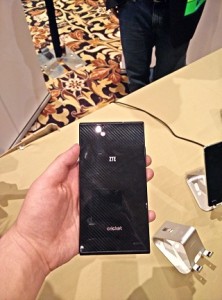Phablets are the new black these days, and ZTE hopes to further the big-screened craze with its Grand X Max+. The 6-inch device, which ZTE dubs the “next-generation version” of last year’s Grand X Max, is coming exclusively to US prepaid outfit Cricket Wireless on January 9, for an affordable $200 off contract. We were able to get our hands on the phone shortly after it was announced at CES this week.
Given that its name has three separate synonyms for the word “big,” it shouldn’t be surprising to hear that the Grand X Max+ is a large smartphone. Or rather, still a large smartphone, as it more or less shares the same mostly rectangular build as its predecessor. Its 6-inch screen is sizable even when compared to most other phablets, and the body that houses it is rather thick, so it’s never going to be totally usable with one hand.
However, we’ve said before that’s not the worst thing in the world, and the Grand X Max+’s design doesn’t feel as overwhelming as its screen size would suggest when held in the hand. That’s mostly due to how light the whole thing is. At 171.8g, it’s not petite, but it’s not as much of a burden to carry around as a Galaxy Note 4 or iPhone 6 Plus.
Part of that comes down to the cheap-feeling plastic that makes up much of the device, but for $200 it’s not overwhelmingly offensive. The look here is plain but clean, and the glass panel on the back, while something of a fingerprint magnet, lends some semblance of a higher-quality feel. We also approve of the rounded top and bottom edges, as they help the phone come off as a little less like your everyday black slab.
The Grand X Max+ has seen some upgrades on the spec sheet, though they’re mostly modest. It now runs on a 1.2 GHz quad-core Snapdragon 400 chipset alongside 2 GB of RAM, which is fair enough for a phone of its price. We didn’t notice any major issues scrolling through the OS or opening up apps, but it’s definitely not something we’d call fast either. It’s still a $200 phone, just
Outside of that, the device now comes with 16 GB of internal storage (up from 8 GB), with up to 32 GB addable through a microSD slot, as well a 3,200 mAh battery. The latter sounds fine on paper, but ZTE’s only promised 6.5 hours of talk time, which is strangely low. The company says it’ll feature Qualcomm’s rapid charging tech as well, however.
The software setup is the same as before, with ZTE’s inoffensive but somewhat boring skin sitting over the slightly outdated Android 4.4.4 KitKat. It doesn’t mess much with the basic usability of the OS, but it doesn’t add much either, and it’s got a rather generic aesthetic. Our demo unit was also loaded up with a fair amount of bloatware, which is unfortunately common amongst carrier exclusives like this.
The 6-inch elephant in the room is still in the Grand X Max+’s display. It’s spacious, and ZTE’s done a good job surrounding it with nicely thin bezels, but it’s only 720p. That’s only good for a pixel density of 245 ppi, which is pretty rough. It’s understandable if ZTE felt it couldn’t meet that $200 price point with a 1080p panel, but there doesn’t seem to be much point in the display being 6 inches (instead of even 5.5) if the only thing that size is going to do is make the screen grainier and make the body less convenient to hold.
Inexpensive phones like the Moto G get away with this explicitly because they’re smaller; it’s a harder sell when something this big tries to make the same sacrifices. The panel looked decent enough during our demo, with serviceable contrast and solid brightness, but viewing angles were subpar, and the lack of sharpness hung over the whole experience. If we want to be positive about it, the low resolution should ensure at least decent battery life.
In any case, the “+” part of the Grand X Max+ derives from two welcome upgrades. One is that the phone now supports LTE — the previous model was HSPA+ only — which is always great to see at a price this low. The other boost comes to the cameras, which have gone from 8- and 1-megapixels on the Grand X Max to 13- and 5-megapixels here. We found both new cams to wash out bright colors a little bit, but on the whole their performance was much better than usual for a device this cheap. The front camera seemed particularly admirable, with a good eye for detail and a wide-angle lens capable of capturing lots of space in each shot.
ZTE wouldn’t confirm or deny whether the Grand X Max+’s arrival will boot the original Grand X Max from the market or lower its price tag even further, but either way, the former looks to be a respectable midrange device. It’s not premium, and it’ll be hard to justify its massive size when its display resolution only meets the minimum, but those who want the other benefits a phablet can provide and prioritize price above all else should find enough to like here.
The post ZTE Grand X Max+ Hands-On: Bigger and Better? appeared first on Brighthand.com.

